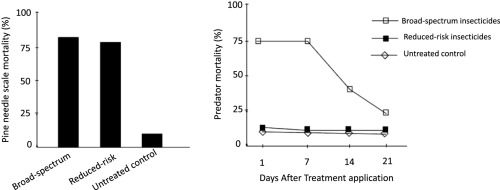当前位置:
X-MOL 学术
›
Crop Prot.
›
论文详情
Our official English website, www.x-mol.net, welcomes your
feedback! (Note: you will need to create a separate account there.)
Residual toxicity of insecticides to Chrysoperla rufilabris and Rhyzobius lophanthae predators as biocontrol agents of pine needle scale
Crop Protection ( IF 2.5 ) Pub Date : 2020-04-01 , DOI: 10.1016/j.cropro.2019.105044 C.R. Quesada , C.S. Sadof
Crop Protection ( IF 2.5 ) Pub Date : 2020-04-01 , DOI: 10.1016/j.cropro.2019.105044 C.R. Quesada , C.S. Sadof

|
Abstract Determining toxicity of insecticides to natural enemies is essential for integrated pest management (IPM) programs of armored scales. In our previous work, insecticides did not affect seasonal abundance of parasitoids and predators of scale insects when they were applied one-month before their peak of season activity. In contrast, when applied during periods of natural enemy activity, trees treated with the broad-spectrum insecticide bifenthrin had fewer parasitoids and predators than trees treated with horticultural oil or the reduced risk insecticides pyriproxyfen, spiromesifen, and spirotetramat. In the current study we determined whether, bifenthrin, and the other insecticides differed in residual toxicity to two common predators, Chrysoperla rufilabris Burmeister (Neuroptera: Chrysopidae) and Rhyzobius lophanthae Blaisdell (Coleoptera: Coccinellidae). First we developed a bioassay that provided predators adequate resources to survive our eight day bioassay. Then, field-grown pine trees were infested with pine needle scale, Chionaspis pinifoliae (Fitch) (Hemiptera: Diaspididae), and treated with insecticides. Pine needles were collected for use in a bioassay that exposed C. rufilabris and R. lophanthae to insecticide residues of different ages. All insecticide treatments reduced live pine needle scales compared to an untreated control. Residues of bifenthrin were slightly toxic to R. lophanthae adult 21 DAT (days after treatment) but were harmless to C. rufilabris larvae 14 DAT. In contrast, horticultural oil and pyriproxyfen, spiromesifen, and spirotetramat did not kill C. rufilabris or R. lophanthae 1 DAT. Our data showed that reduced-risk insecticides can kill pine needle scale and have less residual toxicity than the broad-spectrum insecticide bifenthrin on both C. rufilabris and R. lophanthae.
中文翻译:

杀虫剂对作为松针鳞病生物防治剂的 Chrysoperla rufilabris 和 Rhyzobius lophanthae 天敌的残留毒性
摘要 确定杀虫剂对天敌的毒性对于装甲规模的综合害虫管理 (IPM) 计划至关重要。在我们之前的工作中,在季节活动高峰前一个月施用杀虫剂时,杀虫剂不会影响寄生蜂和介壳虫捕食者的季节性丰度。相比之下,当在天敌活动期间施用时,用广谱杀虫剂联苯菊酯处理的树木比用园艺油或降低风险的杀虫剂吡丙醚、螺螨酯和螺虫乙酯处理的树木具有更少的寄生物和捕食者。在当前的研究中,我们确定了联苯菊酯和其他杀虫剂对两种常见捕食者 Chrysoperla rufilabris Burmeister(Neuroptera:Chrysopidae) 和 Rhyzobius lophanthae Blaisdell(鞘翅目:瓢虫科)。首先,我们开发了一种生物测定,为捕食者提供了足够的资源,使我们的八天生物测定能够存活下来。然后,田间种植的松树被松针鳞、松针叶螟(Fitch)(半翅目:双翅目)侵染,并用杀虫剂处理。收集松针用于将 C. rufilabris 和 R. lophanthae 暴露于不同年龄的杀虫剂残留物的生物测定中。与未经处理的对照相比,所有杀虫剂处理都减少了活松针鳞屑。联苯菊酯的残留物在 21 DAT(处理后的天数)后对 R. lophanthae 成虫略有毒性,但对 C. rufilabris 幼虫 14 DAT 无害。相比之下,园艺油和吡丙醚、螺螨酯和螺虫乙酯不能杀死 C. rufilabris 或 R. lophanthae 1 DAT。
更新日期:2020-04-01
中文翻译:

杀虫剂对作为松针鳞病生物防治剂的 Chrysoperla rufilabris 和 Rhyzobius lophanthae 天敌的残留毒性
摘要 确定杀虫剂对天敌的毒性对于装甲规模的综合害虫管理 (IPM) 计划至关重要。在我们之前的工作中,在季节活动高峰前一个月施用杀虫剂时,杀虫剂不会影响寄生蜂和介壳虫捕食者的季节性丰度。相比之下,当在天敌活动期间施用时,用广谱杀虫剂联苯菊酯处理的树木比用园艺油或降低风险的杀虫剂吡丙醚、螺螨酯和螺虫乙酯处理的树木具有更少的寄生物和捕食者。在当前的研究中,我们确定了联苯菊酯和其他杀虫剂对两种常见捕食者 Chrysoperla rufilabris Burmeister(Neuroptera:Chrysopidae) 和 Rhyzobius lophanthae Blaisdell(鞘翅目:瓢虫科)。首先,我们开发了一种生物测定,为捕食者提供了足够的资源,使我们的八天生物测定能够存活下来。然后,田间种植的松树被松针鳞、松针叶螟(Fitch)(半翅目:双翅目)侵染,并用杀虫剂处理。收集松针用于将 C. rufilabris 和 R. lophanthae 暴露于不同年龄的杀虫剂残留物的生物测定中。与未经处理的对照相比,所有杀虫剂处理都减少了活松针鳞屑。联苯菊酯的残留物在 21 DAT(处理后的天数)后对 R. lophanthae 成虫略有毒性,但对 C. rufilabris 幼虫 14 DAT 无害。相比之下,园艺油和吡丙醚、螺螨酯和螺虫乙酯不能杀死 C. rufilabris 或 R. lophanthae 1 DAT。











































 京公网安备 11010802027423号
京公网安备 11010802027423号